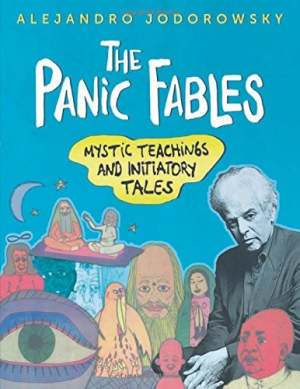The Panic Fables
Mystic Teachings and Initiatory Tales
This remarkable collection demonstrates that art, even in a form as humble as the weekly newspaper comic strip, can be transformative.
Panic Fables compiles 284 comic strips from Alejandro Jodorowsky, published between 1967 and 1973. Drawing wisdom from multiple philosophies and religions, this work is strange and wonderful.
Jodorowsky is perhaps best known for his controversial films and plays. The content of these comics is highly thought-provoking. Taken as a whole, they show the transformation of the central character, who is based on Jodorowsky, as he goes from being a seeker sitting in front of his teacher, to being a teacher himself. They are consistently compelling, starting with strips that are dark and pessimistic, and eventually transforming to tell stories that are hopeful and depict an optimistic, spiritual worldview.
Artwork consists of simple figures and bright colors that come together to create nearly psychedelic images. The text is incorporated seamlessly into the drawings—sometimes presented in word bubbles, sometimes written upside down, and sometimes wrapping around the images. These images speak to the time and culture in which they were produced and beautifully capture the philosophical message of the fables.
Some of the comics take a great deal of thought to really process. Others are profoundly meaningful in their simplicity. In one fable, Jodorowsky describes a disciple who would remove his shoes when he came to his master’s house, but not when he visited a friend. Another disciple removed his shoes whenever he entered anyone’s home. The master explains the difference between these two disciples: “When you truly discover the meaning of the sacred in one thing you will also know the sacred in all other things.”
This remarkable collection demonstrates that art, even in a form as humble as the weekly newspaper comic strip, can be transformative, inspiring awe and even offering guidance. Panic Fables is a must-read for anyone interested in the history of comics or in comics as a literary art form.
Reviewed by
Catherine Thureson
Disclosure: This article is not an endorsement, but a review. The publisher of this book provided free copies of the book to have their book reviewed by a professional reviewer. No fee was paid by the publisher for this review. Foreword Reviews only recommends books that we love. Foreword Magazine, Inc. is disclosing this in accordance with the Federal Trade Commission’s 16 CFR, Part 255.

